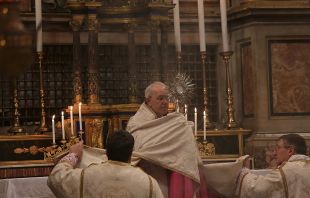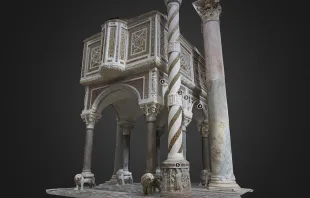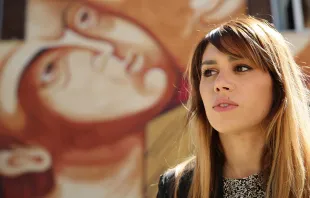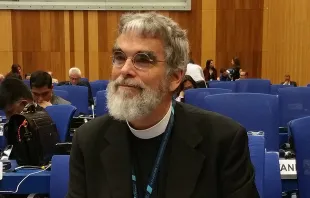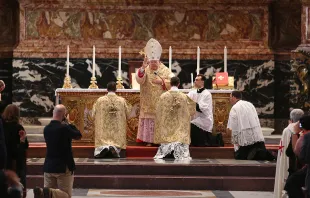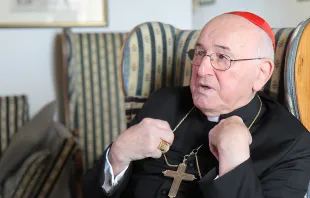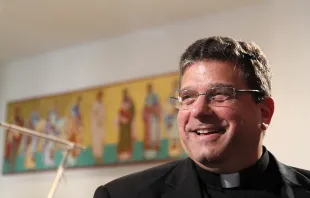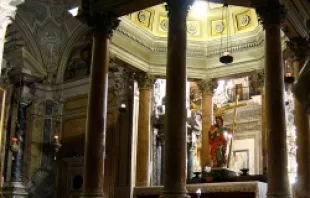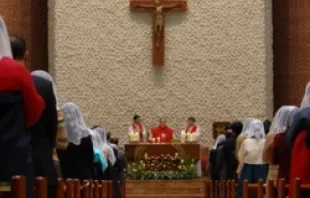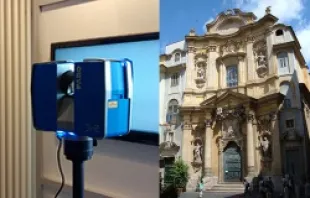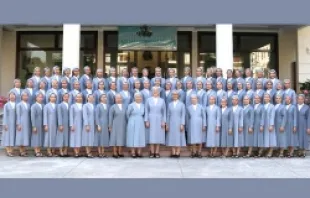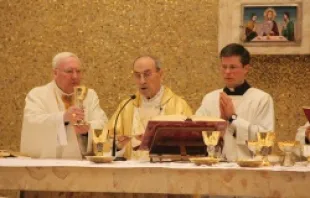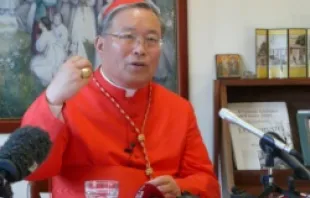Articles by Jan Bentz
Byte-sized faith: Young priests launch new Catholic podcast
Jul 16, 2015 / 03:02 amPodcasts are arguably the greatest comeback-kids of the internet. Once thought to be slowing fading into oblivion, the boom of smartphones and Bluetooth technology, and hits like “Serial,” brought the medium back with a force.
Summorum Pontificum Conference celebrates Benedict XVI's liturgical legacy
Jun 19, 2015 / 06:07 amThe fourth annual Summorum Pontificum Conference was held last Saturday in Rome to promote the understanding and use of the extraordinary form of the Roman rite, and to discuss the liturgical heritage of Benedict XVI.
3D technology takes pilgrims 'back in time' to Medieval Church
Jun 9, 2015 / 02:55 amFor fans of Church history and architecture, 3D imaging may be the second-best thing to time travel, allowing them to experience a medieval church as it existed hundreds of years ago.
What happens when beautiful street art meets a Rome ghetto?
Apr 23, 2015 / 03:02 amStreet artists from 10 countries around the globe gathered in Rome and put their talents to use in creating an outdoor art exhibit designed to place beauty at the center of an impoverished neighborhood.
As church-goers wane, Germany's controversial tax prompts unease
Feb 12, 2015 / 04:02 amWhile church attendees dwindle in Germany, questions have arisen once again over the controversial state-imposed church tax – and whether it's time for the country's bishops to address concerns around it.
Vatican astronomers unlock the mysteries of the universe…sort of
Jan 8, 2015 / 04:03 amVatican astronomer Brother Guy Consolmagno was 30 years old and just starting his career as an astronomer when he faced a personal crisis.
Cardinal Burke opens up about his new office with Knights of Malta
Nov 29, 2014 / 06:01 amOn Nov. 8 the Vatican announced the transfer of Cardinal Raymond Burke from prefect of the Apostolic Signatura, which ensures correct administration of justice in the Church, to Patron of the Sovereign Order of the Knights of Malta.
True pastoral work never contradicts doctrine, cardinal stresses
Oct 5, 2014 / 04:17 amAs bishops from around the world prepare to discuss pastoral solutions to various challenges surrounding the family, German Cardinal Walter Brandmüller explained that these solutions cannot oppose Church teaching.
Taking Gospel seriously on marriage is not 'rigid' – it's love
Oct 4, 2014 / 04:58 amThe editor of a high-profile book on marriage said that adhering to Christ’s Gospel teachings on divorce is not harsh and mean-spirited, but rather a form of tough love aimed at the salvation of souls.
Giuseppe Canovai, a Roman who left a community as his legacy
Jul 30, 2014 / 23:03 pmFamilia Christi is the Roman community formed by Fr. Giuseppe Canovai, a priest of the city whose life united Franciscan poverty and the Jesuit spirituality.
124 Korean martyrs to be beatified by Pope next month
Jul 30, 2014 / 01:04 amDuring his August visit to Korea, Pope Francis is to beatify Paul Yun Ji-chung, the nation's first martyr, as well as 123 companions who were killed for the faith in the 19th century.
Papal trip to Korea should renew local Churches, priest says
Jul 17, 2014 / 12:01 pmIn the run up to Pope Francis visit to South Korea next month, a Korean priest said he expects ground breaking changes there in terms of peace and the Church’s service to society.
Rome church restoration boosted by unique 3D scanner
Jun 15, 2014 / 15:02 pmAssisting in restoration and reconstruction for artists and architects alike, 3D scanner technology has recently been used to create unique point cloud models of churches and frescoes in Rome.
John XXIII: More than Just a 'good Pope'
Apr 21, 2014 / 00:00 amJohn XXIII's political engagement as well as his invocation of the Second Vatican Council shows how he fits perfectly in an ongoing movement of his predecessor, Pius XII and one of his successors, John Paul II – the latter being canonized on the same day as him.Although many cardinals and officials understood John XXIII to be a Pope of transition, his decisions during his pontificate would prove them wrong.In his early life, Angelo Giuseppe Roncalli served as a nuncio in France and as the Vatican’s delegate to Bulgaria and Greece. He was appointed a cardinal by Pope Pius XII in 1953, and was nominated Patriarch of Venice. His papacy began with his election on Oct. 28, 1958 at the age of 76. All throughout his career he held good relations with politicians, both Catholic and secular. This is illustrated for example, by the fact that Roncalli received his red Biretta as a symbolic gesture from Vincent Auriol, French president from 1947-1954, during an audience.In the late ‘50s, Charles de Gaulle, then French President, demanded that the Catholic Church dispose of all their bishops in France, with the exception of four, since he had accused them of collaboration with the Vichy-Government and the Nazis during the occupation. Due to masterful diplomacy, Roncalli was able to clear the records of the bishops, and ultimately only two of them were removed instead of 36.Thus, he prevented politicians interfering with the ecclesiastical hierarchy in France. By doing so, he also prevented many problems and struggles for the Church, especially during her precarious situation at the time.Ulrich Nersinger, German Church historian and specialist on the Vatican and the newer history of the Popes, commented in an interview given to CNA on April 11 that “Pope John XXIII did not think in Ideologies.”Rather, “he saw the social doctrine of the Church as the way between extremes. For him, that meant to fight for the rights of the workers, but at the same time to defend the interests of other social classes.”“He advocated a grounded over-arching view of all problems, relevant to society.”In his political and diplomatic career, John XXIII had exceptional success in Church matters, which was particularly evident in the invoking of the Second Vatican Council. His ties to the past are twofold in this regard.For one, John XXIII wanted to bring the works of the First Vatican Council to an end, which had been interrupted abruptly by the Franco-Prussian war in 1870. This was seen in the Constitution of the Council on the Liturgy “Sacrosanctum Concilium,” which was the first published document of the Second Vatican Council, even though a Council would never begin with discussions on the liturgy. The reason for this was that he wanted to pick up on the topics where Vatican I had left off.Furthermore, John XXIII saw himself continuing the work of Pius XII, who had tried to give the Catholic Church a positive image during the post-war era.“John XXIII did not see himself as a counter-measure to his predecessor – he was well aware of the difficult decisions Pacelli had to make and had admired him for them. In his first audience, he explained: ‘pray to the Lord that my work as your new Shepard stays on the illuminated path of Pius XII,’” Nersinger explained.John XXIII continued Pius XII’s work in reforming the liturgy of Holy Week in the Roman Rite. In regard to the reforms, he always emphasized the use of the Latin language as seen in his 1962 published Apostolic Constitution, “Veterum Sapientiae”.Ties to his successor can be observed in the political question of Communism.John XXIII was concerned with the overpowering presence of Communism in all European countries, and well aware that this was a problem, believed that the Church would need to deal with this in the foreseeable future. Little would he have guessed, that John Paul II – who very fittingly, will be canonized on the same day – had the kind of impact that led to the fall of Communism, firstly in Poland and then in other countries.Countless anecdotes tell of the strong will of John XXIII in important decisions.The Pontiff himself, often recalled a story from the pontificate of Pius IX that he paralleled with the overcoming of the resistance against the opening of the council.“In order to vote for his decision of a general amnesty that Pius IX wanted to invoke, he let the cardinals vote, as it was custom, with black and white pearls representing their negative or positive vote."“The number of white pearls was evidently small. He took his white cap – the Pileolus – off, covered the black pearls and exclaimed: ‘now they are all white,’” recalls Nersinger. John XXIII saw himself, in the same situation, convoking the council against contrary voices.Much more than just a “good Pope” as he is sometimes made out to be, John XXIII was a saint. The Church, recognizing this, will canonize him in only a little less than a week.
Blossoming religious order in France sees global impact
Apr 14, 2014 / 09:23 amA missionary order founded in the middle Ages in France is sending their burgeoning number of vocations from Asia and especially South Korea to evangelize countries throughout the world.
Legion's general director affirms Christ-centered spirituality
Feb 28, 2014 / 15:04 pmAt the conclusion of the Legion of Christ’s general chapter, the order’s recently elected general director, Fr. Eduardo Robles Gil, confirmed their commitment to Christ and his reign.
Pope Francis to new cardinal: 'I love Korea'
Feb 26, 2014 / 18:03 pmDuring the Feb. 23 Mass of Thanksgiving for the creation of new cardinals, Pope Francis offered words of affection for the newly-elevated South Korean cardinal’s home country.




